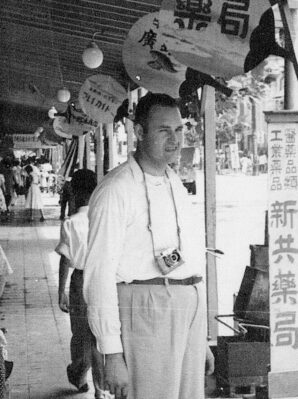
Visitors march past Yoshino cherry blossoms near the Tidal Basin on Thursday, March 23, 2023, in Washington. (AP Photo/Nathan Howard)
Memorandum for the Director, Naval Intelligence
The Pentagon, Washington, D.C.
“May I take this opportunity of commending your officer for his efforts in this matter; without the knowledge of the French language, he was able to make contact with one of the cleverest band of Corsican counterfeit passers operating in the Mediterranean Basin, a band which the Surete’ Nationale had been trying to disperse for a number of years; he obtained the confidence of the members of this band who, heretofore, had boasted that no police officer would ever enter into their organization under the guise of a purchaser. He did this through his own resourcefulness, as no one was there to guide him while in contact with members of this band.”
Very truly yours,
A.A. Christides
U.S. Treasury Representative, Paris, France
December 31, 1952
OK: this is a little complex in terms of times this morning. We are sitting and looking at a pleassant 4th day of Spring. It is still yearly in a new decade vibrant with life. The Cherry Blossoms here in Washington? Today is the Day we hit Stage Six. So, we ought to remember this one, since it could be one of those world historic days people look back on and say “What on Earth were those people thinking?”
In the case of this particular Thursday in late March, President Xi of China traveled to Moscow to announce everything is going to be different in the world. According to him, the American Century is officially “done.” Given the festival of odd news cascading through the cycle, it is entirely possible he is right. But what a thrill it has been to live in this time in this wonderful place!
Just in case it is almost over, we thought we would drag out some ancient history, courtesy of Big Smoke Tom Duvall. This sea story dates back to the early 1950s, when the world was remade by America’s strength. We got a long note back in 2008 from Big Smoke about another earlier year. He was retired then and dead now, both events deep in the country. Back then, Tom was sculpting his memoirs, and I agreed to help get some of them ready for publication. This is his story, not ours, but bear with us, since he gave us the sea story, but not the full context of those times.
And a note about those times. It is the only letter Socotra House has recieved that contained a threat and a request. It came in a warning to use only his words, since if any others were used there could be trouble.
Put your feet up and relax. It is 1952. The war in Korea is an unpopular and bloody stalemate, and peace talks have been postponed. The final peace treaty with Japan, the war before, is just seven months old, and the former enemy has regained the appurtenances of self-government. That is one of the reason Big Smoke was back from Japan, where he had been the Top Cop in Yokosuka under military law.

(Big Smoke in the 1950s, camera ready).
It is a curious thing from long ago. People were still talking about the UFO scare here on the
East Coast. Unidentified objects had buzzed the capital, taking evasive action after fighters were scrambled to investigate, and which returned after the jets departed. Sound familiar? Sometimes we need the aliens and sometimes we don’t.
In that same month, General of the Army Dwight Eisenhower had been elected President, and the US military had detonated the first hydrogen bomb at Eniwetok atoll. The Navy had laid the keel for the first nuclear-powered submarine, named for the craft imagined first by author Jules Verne. The USS Nautilus (SSN-571).
Regardless of how strange things are right now as we labor through our version of the Roaring Twenties, the year of 1952 has all the strangeness anyone can handle. Big Smoke said it this way:
“I was assigned to the Naval District Intelligence Office, located on the grounds of the Naval Observatory on Massachusetts Avenue in Northwest Washington. In those days, the District was responsible for most of the day-to-day activities of the Service.”
“The District managed the Shore Patrol, determined uniform policy, maintained security and ran Naval Intelligence in its area of responsibility. Just up the road was Ward Circle, where the Navy had run the big secret of WW II- the code-breaking activities that helped beat Japan. Goodness knows what they were doing in 1952. We knew later, but it was a place you did not talk about.”
The Observatory was home to the Chief of Naval Operations. That was before the stately home at Number 1 Observatory Circle was appropriated by the Vice President. It was home to one of the oldest scientific agencies in the country, having been established in 1830 to surpass Greenwich as the premier center of the science for safe navigation.
The Depot of Charts and Instruments took care of the U.S. Navy’s precision chronometers and maps. It had been downtown on the Potomac, at Navy Hill in Foggy Bottom until 1893, when pollution from the growing number of lights rendered the telescopes inefficient for precision measurements.
The Admirals selected a perfect circle of property on the heights above the city at 3450 Massachusetts Avenue Northwest. The observatory and library were considered as “world class” since the compound was far away from the lights of the downtown area.
Since 1845, the Observatory had determined the time with the world’s first vulcanized time ball, created to Superintendent Matthew Fontaine Maury’s specifications by Charles Goodyear. It was installed atop the dome of the 9.6-inch telescope. When the time-ball was dropped, a flag was mechanically raised, letting all ships and civilians know it was precisely noon.
By the time I was there the time ball was gone, and the Observatory determined time with a photographic zenith tube (PZT), an instrument that points straight up and photographs selected stars crossing the zenith. The Time Service transmitted the data via telegraph lines to the Navy Department. It also activated the Washington fire bells at 0700, 1200, and 1800.
When Tom got orders to the Observatory to work for ONI’s Director of Counterintelligence, they had him take up residence in Kalorama, a DC neighborhood on Wyoming Avenue. Character of it? A lot of embassies and counselor residences. Today, the place he lived in is the first large building on the left of an old home at 2107 Wyoming Ave, and it has a sign on it, “The French School.”
Directly across from this is a white office building that was the office of the Director of SDEC- the Service de Documentation Exterieure et de Contre-espionnage. His name was Philipe Thyraud de Vosjoli, and he was head of French Intelligence in the United States (and had a beautiful assistant by the name of Janine but that’s another story).
The French had a problem with currency, and they wanted some help. That is how I wound up in Europe, assigned to liaison duties with the Surite Nationale.
Halfway down the block on Wyoming Avenue was the home of the Director of Naval Intelligence, Rear Admiral Carl F. Espe.
As we generally went to work about the same time, we often would stop and have a few words. It was the last week in November 1952 when I was told that my boss, the District Intelligence Officer, Captain Noble Abrahams, wanted to see me. He called me into his office and said the DNI needed to see me right away and that one of the agents was bringing a car around to take me up to the Pentagon and would wait to bring me back.
When we arrived at the DNI’s office, the secretary told me to go right in, they were waiting for me. I went in and there were several people in the office with Admiral Espe. The Admiral immediately went into the problem at hand, stating that whenever Sixth Fleet vessels went into French ports, it was flooded with U.S. counterfeit currency. The French were getting very upset over this, particularly since no military organizations in Europe would give them any assistance, and the U.S. Treasury Department had no agents in Europe to deal with counterfeit cash.
Here was the root of the problem. At that time in the 1950’s, all military and U.S. Government personnel stationed in Europe were paid in MPC (Military Payment Certificates) except for Naval Personnel stationed aboard ships operating in the area. Needless to say, they knew they could get much more on the Black Market, although they were instructed to exchange their dollars for local currency.
The Admiral went on to say that he remembered talking to me on his visits to Yokosuka that I often mentioned that we had problems with counterfeiting. What would I think of going to France and helping the Surete’ out with the problem they had? Of course, I told him I was ready to leave immediately. Then somebody spoke up and said “Admiral, he has to get a passport and that’s going to take at least 48 hours.”
Admiral Espe said “Let’s get on with the problem and stop talking about it. Tom, while you are gone I will take care of your apartment.”
With that we went out. The agent who had brought me to the Pentagon was waiting. The Captain told him: “Take Tom and get him into uniform – he has to be in one for this project. Get him up to the Bureau of Personnel- BUPERS- and start processing him to get a U.S. passport.”
It was done and in the first week in December, 1952, I departed from the MATS (Military Airport Transport Service) Terminal, Washington National Airport, arriving at Orly Airport France on the first Sunday in December. That would be where this adventure in the American Century begins. More on that tomorrow, though, when the Cherry Blossoms are ripe and waving around the Tidal Basin!
Copyright 2023 Vic Socotra
www.vicsocotra.com
